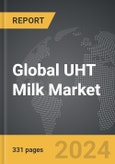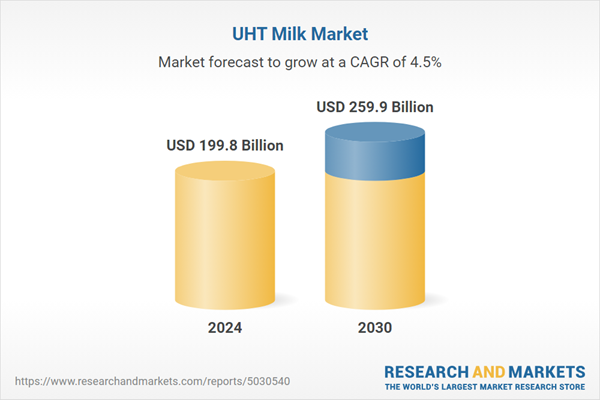The global market for UHT Milk was valued at US$199.8 Billion in 2024 and is projected to reach US$259.9 Billion by 2030, growing at a CAGR of 4.5% from 2024 to 2030. This comprehensive report provides an in-depth analysis of market trends, drivers, and forecasts, helping you make informed business decisions. The report includes the most recent global tariff developments and how they impact the UHT Milk market.
Segments: Segment (Whole UHT Milk, Semi-Skimmed UHT Milk, Skimmed UHT Milk).
Geographic Regions/Countries: World; United States; Canada; Japan; China; Europe (France; Germany; Italy; United Kingdom; Spain; Russia; and Rest of Europe); Asia-Pacific (Australia; India; South Korea; and Rest of Asia-Pacific); Latin America (Argentina; Brazil; Mexico; and Rest of Latin America); Middle East (Iran; Israel; Saudi Arabia; United Arab Emirates; and Rest of Middle East); and Africa.
The analysts continuously track trade developments worldwide, drawing insights from leading global economists and over 200 industry and policy institutions, including think tanks, trade organizations, and national economic advisory bodies. This intelligence is integrated into forecasting models to provide timely, data-driven analysis of emerging risks and opportunities.
Global UHT Milk Market - Key Trends & Drivers Summarized
What Is Making UHT Milk More Popular in Global Markets?
Ultra-High Temperature (UHT) milk has gained significant traction in global markets due to its convenience, long shelf life, and ability to retain nutritional content without refrigeration until opened. UHT milk undergoes a heating process at high temperatures (135°C to 150°C) for a short period, killing harmful bacteria and microorganisms while preserving essential vitamins and proteins. Its long shelf life of up to 6 months makes it a preferred choice in regions with limited access to refrigerated storage. As lifestyles become busier and urbanization increases, the demand for easily accessible, longer-lasting food products is on the rise. This is particularly true in developing nations, where UHT milk offers a reliable solution to milk supply chain challenges.How Is UHT Milk Shaping Consumer Habits and Preferences?
Changing consumer preferences towards ready-to-use and convenient food products have directly influenced the rising demand for UHT milk. The product's ease of use, storage benefits, and packaging flexibility make it ideal for households and businesses alike. In regions with high population densities and limited cold storage infrastructure, UHT milk offers a safe, nutritious alternative to fresh milk. Additionally, UHT milk is available in various fat contents - whole, semi-skimmed, and skimmed - catering to diverse dietary needs. The growing trend of single-person households and the demand for smaller, convenient portions further fuels its popularity. Consumers seeking healthier, additive-free products also favor UHT milk for its minimal processing and lack of preservatives.How Are Technological Advancements Impacting the UHT Milk Market?
Technological advancements in processing and packaging have significantly improved the quality and marketability of UHT milk. Innovations in aseptic packaging ensure that the milk remains fresh without preservatives, while advanced sterilization techniques protect the milk's nutritional content. Packaging technology has also evolved to cater to varying consumer needs, from single-serve packs to family-sized containers. Additionally, environmental concerns have prompted the development of eco-friendly packaging materials, with a push toward recyclable cartons and biodegradable options. The automation of UHT milk production processes has also increased efficiency and reduced costs for manufacturers, allowing them to meet growing global demand while maintaining high-quality standards.What Is Driving Growth in the UHT Milk Market?
The growth in the UHT milk market is driven by several factors, including rising urbanization, improvements in cold-chain logistics, and the growing demand for shelf-stable dairy products. Urbanization has led to busier lifestyles, driving demand for convenient, long-lasting food products. The increase in population in regions with unreliable refrigeration infrastructure has further boosted demand for UHT milk, particularly in Asia, Africa, and the Middle East. Moreover, as international trade of dairy products expands, UHT milk's durability during transportation makes it ideal for long-distance shipping. Additionally, growing health-consciousness among consumers, along with the rising popularity of lactose-free and fortified UHT milk options, is fueling market growth. These trends are transforming UHT milk into a key player in the global dairy industry.Report Scope
The report analyzes the UHT Milk market, presented in terms of units. The analysis covers the key segments and geographic regions outlined below.Segments: Segment (Whole UHT Milk, Semi-Skimmed UHT Milk, Skimmed UHT Milk).
Geographic Regions/Countries: World; United States; Canada; Japan; China; Europe (France; Germany; Italy; United Kingdom; Spain; Russia; and Rest of Europe); Asia-Pacific (Australia; India; South Korea; and Rest of Asia-Pacific); Latin America (Argentina; Brazil; Mexico; and Rest of Latin America); Middle East (Iran; Israel; Saudi Arabia; United Arab Emirates; and Rest of Middle East); and Africa.
Key Insights:
- Market Growth: Understand the significant growth trajectory of the Whole UHT Milk segment, which is expected to reach US$68.7 Billion by 2030 with a CAGR of a 3.7%. The Semi-Skimmed UHT Milk segment is also set to grow at 4.7% CAGR over the analysis period.
- Regional Analysis: Gain insights into the U.S. market, valued at $52.8 Billion in 2024, and China, forecasted to grow at an impressive 6.6% CAGR to reach $55.0 Billion by 2030. Discover growth trends in other key regions, including Japan, Canada, Germany, and the Asia-Pacific.
Why You Should Buy This Report:
- Detailed Market Analysis: Access a thorough analysis of the Global UHT Milk Market, covering all major geographic regions and market segments.
- Competitive Insights: Get an overview of the competitive landscape, including the market presence of major players across different geographies.
- Future Trends and Drivers: Understand the key trends and drivers shaping the future of the Global UHT Milk Market.
- Actionable Insights: Benefit from actionable insights that can help you identify new revenue opportunities and make strategic business decisions.
Key Questions Answered:
- How is the Global UHT Milk Market expected to evolve by 2030?
- What are the main drivers and restraints affecting the market?
- Which market segments will grow the most over the forecast period?
- How will market shares for different regions and segments change by 2030?
- Who are the leading players in the market, and what are their prospects?
Report Features:
- Comprehensive Market Data: Independent analysis of annual sales and market forecasts in US$ Million from 2024 to 2030.
- In-Depth Regional Analysis: Detailed insights into key markets, including the U.S., China, Japan, Canada, Europe, Asia-Pacific, Latin America, Middle East, and Africa.
- Company Profiles: Coverage of players such as Arla Foods Amba, Candia, Danone SA, DMK Deutsches Milchkontor GmbH, Fonterra Co-Operative Group Ltd. and more.
- Complimentary Updates: Receive free report updates for one year to keep you informed of the latest market developments.
Some of the 58 companies featured in this UHT Milk market report include:
- Arla Foods Amba
- Candia
- Danone SA
- DMK Deutsches Milchkontor GmbH
- Fonterra Co-Operative Group Ltd.
- Grupo Lala S.A. de C.V.
- Inner Mongolia Yili Industrial Group Co., Ltd.
- Lactalis Group
- Murray Goulburn Co-operative Co., Ltd.
- Nestle SA
- Parmalat S.P.A.
- Savencia Fromage & Dairy
- Sodiaal International
- Unternehmensgruppe Theo Muller S.e.c.s
Tariff Impact Analysis: Key Insights for 2025
Global tariff negotiations across 180+ countries are reshaping supply chains, costs, and competitiveness. This report reflects the latest developments as of April 2025 and incorporates forward-looking insights into the market outlook.The analysts continuously track trade developments worldwide, drawing insights from leading global economists and over 200 industry and policy institutions, including think tanks, trade organizations, and national economic advisory bodies. This intelligence is integrated into forecasting models to provide timely, data-driven analysis of emerging risks and opportunities.
What’s Included in This Edition:
- Tariff-adjusted market forecasts by region and segment
- Analysis of cost and supply chain implications by sourcing and trade exposure
- Strategic insights into geographic shifts
Buyers receive a free July 2025 update with:
- Finalized tariff impacts and new trade agreement effects
- Updated projections reflecting global sourcing and cost shifts
- Expanded country-specific coverage across the industry
Table of Contents
I. METHODOLOGYII. EXECUTIVE SUMMARY2. FOCUS ON SELECT PLAYERSIII. MARKET ANALYSISIV. COMPETITION
1. MARKET OVERVIEW
3. MARKET TRENDS & DRIVERS
4. GLOBAL MARKET PERSPECTIVE
UNITED STATES
CANADA
JAPAN
CHINA
EUROPE
FRANCE
GERMANY
ITALY
UNITED KINGDOM
SPAIN
RUSSIA
REST OF EUROPE
ASIA-PACIFIC
AUSTRALIA
INDIA
SOUTH KOREA
REST OF ASIA-PACIFIC
LATIN AMERICA
ARGENTINA
BRAZIL
MEXICO
REST OF LATIN AMERICA
MIDDLE EAST
IRAN
ISRAEL
SAUDI ARABIA
UNITED ARAB EMIRATES
REST OF MIDDLE EAST
AFRICA
Companies Mentioned (Partial List)
A selection of companies mentioned in this report includes, but is not limited to:
- Arla Foods Amba
- Candia
- Danone SA
- DMK Deutsches Milchkontor GmbH
- Fonterra Co-Operative Group Ltd.
- Grupo Lala S.A. de C.V.
- Inner Mongolia Yili Industrial Group Co., Ltd.
- Lactalis Group
- Murray Goulburn Co-operative Co., Ltd.
- Nestle SA
- Parmalat S.P.A.
- Savencia Fromage & Dairy
- Sodiaal International
- Unternehmensgruppe Theo Muller S.e.c.s
Table Information
| Report Attribute | Details |
|---|---|
| No. of Pages | 331 |
| Published | April 2025 |
| Forecast Period | 2024 - 2030 |
| Estimated Market Value ( USD | $ 199.8 Billion |
| Forecasted Market Value ( USD | $ 259.9 Billion |
| Compound Annual Growth Rate | 4.5% |
| Regions Covered | Global |









